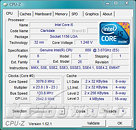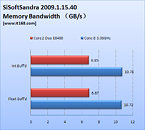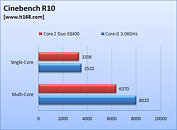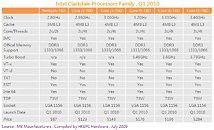- Joined
- Oct 9, 2007
- Messages
- 47,370 (7.52/day)
- Location
- Hyderabad, India
| System Name | RBMK-1000 |
|---|---|
| Processor | AMD Ryzen 7 5700G |
| Motherboard | ASUS ROG Strix B450-E Gaming |
| Cooling | DeepCool Gammax L240 V2 |
| Memory | 2x 8GB G.Skill Sniper X |
| Video Card(s) | Palit GeForce RTX 2080 SUPER GameRock |
| Storage | Western Digital Black NVMe 512GB |
| Display(s) | BenQ 1440p 60 Hz 27-inch |
| Case | Corsair Carbide 100R |
| Audio Device(s) | ASUS SupremeFX S1220A |
| Power Supply | Cooler Master MWE Gold 650W |
| Mouse | ASUS ROG Strix Impact |
| Keyboard | Gamdias Hermes E2 |
| Software | Windows 11 Pro |
"Clarkdale" is the codename for Intel's upcoming dual-core processors derived from the Nehalem/Westmere architecture. The move marks a leap for Intel in two ways: introducting the first commercial-grade 32 nm microprocessor, and implementing a radical new design that involved relocating the platform's northbridge component entirely to the CPU package. Slated for Q1 2010, Clarkdale will go by three brand indentifiers to grade it according to a performance and feature scale. You have the Core i5 class that enables the entire feature-set of processor, there's the Core i3 class that offers some features, excluding Intel Turbo Boost technology for example, finally there's the sub-$100 Pentium part (yes, Pentium lives on), which offers a smaller feature-set. HyperThreading technology is disabled on this one.
Chinese tech-site IT168 published a comprehensive performance (p)review of the 3.06 GHz Clarkdale part. In the article, the 3.06 GHz Clarkdale was pitted against the 3.00 GHz "Wolfdale" Core 2 Duo processor. The memory (Dual-channel DDR3-1333, 4 GB) and graphics hardware (ATI Radeon HD 4870, 1 GB) were kept common between the two test-beds. Tests ranged from memory and CPU internal bandwidth tests, math-intensive tests, synthetic multimedia and 3D tests, and finally, modern 3D games.



With an integrated memory controller, Clarkdale is swimming in higher bandwidth, and lower latency compared to its predecessor, as tested on SANDRA 2009. Having four threads on two cores thanks to HyperThreading, however, doesn't seem to have a significant impact on its performance at the multi-threaded Cinebench R10. Even at the single-core run, the increment is passable at best.


Notable CPU benchmarks from Everest 5, the CPU Z-lib and FPU Julia series (Julia and Sin-Julia) is where the new chip seems to shine with significant increments. A roughly 40 percent increment at Z-lib, and a healthy 90+ percent boost with Sin Junlia. Clarkdale churns out surprisingly high scores with 3DMark Vantage (CPU test), something it doesn't manage with 3DMark06.

If purely gaming is your thing, and you have a current generation machine, these charts will interest you. Popular games such as Enemy Territory: Quake Wars, Far Cry 2, and Crysis Warhead show the two chips to be performing neck and neck.
In related news, HKEPC compiled a neat table listing out Intel's first-wave of Clarkdale-based processors, starting from the sub-$100 Pentium, to the entry-mainstream Core i3, and over to the mainstream-performance Core i5. The models and their tentative prices were sourced from motherboard manufacturers. A bulk of the lineup is positioned in the $126~$196 range. At these prices, they share space with at least one quad-core LGA-1156 processor, the 2.66 GHz Core i5 "Lynnfield" 750, while the 3.46 GHz Clarkdale will be locking horns with the 2.80 GHz Lynnfield at the ~$280 price point. IT168's complete review Google-translated to English can be read here.

View at TechPowerUp Main Site
Chinese tech-site IT168 published a comprehensive performance (p)review of the 3.06 GHz Clarkdale part. In the article, the 3.06 GHz Clarkdale was pitted against the 3.00 GHz "Wolfdale" Core 2 Duo processor. The memory (Dual-channel DDR3-1333, 4 GB) and graphics hardware (ATI Radeon HD 4870, 1 GB) were kept common between the two test-beds. Tests ranged from memory and CPU internal bandwidth tests, math-intensive tests, synthetic multimedia and 3D tests, and finally, modern 3D games.



With an integrated memory controller, Clarkdale is swimming in higher bandwidth, and lower latency compared to its predecessor, as tested on SANDRA 2009. Having four threads on two cores thanks to HyperThreading, however, doesn't seem to have a significant impact on its performance at the multi-threaded Cinebench R10. Even at the single-core run, the increment is passable at best.


Notable CPU benchmarks from Everest 5, the CPU Z-lib and FPU Julia series (Julia and Sin-Julia) is where the new chip seems to shine with significant increments. A roughly 40 percent increment at Z-lib, and a healthy 90+ percent boost with Sin Junlia. Clarkdale churns out surprisingly high scores with 3DMark Vantage (CPU test), something it doesn't manage with 3DMark06.

If purely gaming is your thing, and you have a current generation machine, these charts will interest you. Popular games such as Enemy Territory: Quake Wars, Far Cry 2, and Crysis Warhead show the two chips to be performing neck and neck.
In related news, HKEPC compiled a neat table listing out Intel's first-wave of Clarkdale-based processors, starting from the sub-$100 Pentium, to the entry-mainstream Core i3, and over to the mainstream-performance Core i5. The models and their tentative prices were sourced from motherboard manufacturers. A bulk of the lineup is positioned in the $126~$196 range. At these prices, they share space with at least one quad-core LGA-1156 processor, the 2.66 GHz Core i5 "Lynnfield" 750, while the 3.46 GHz Clarkdale will be locking horns with the 2.80 GHz Lynnfield at the ~$280 price point. IT168's complete review Google-translated to English can be read here.

View at TechPowerUp Main Site






 I saw that too! Reminds me of the P4 days in which that multi had no real meaning in regards to performance.
I saw that too! Reminds me of the P4 days in which that multi had no real meaning in regards to performance. Granted Clarkdale beats it on synthetic benchmarks and a nice boost in 3DMarks too, but not so much that warrants building a new system.
Granted Clarkdale beats it on synthetic benchmarks and a nice boost in 3DMarks too, but not so much that warrants building a new system.